FRIDAY
AUGUST 30 - 2013
BROOK
MEADOW
Knopper
Galls
While walking through
Brook Meadow this afternoon, I noticed that the young
Pedunculate Oak on the east side of the north meadow,
south of the Rowan plantation, was infected with
hundreds of very hard green knobbly galls.
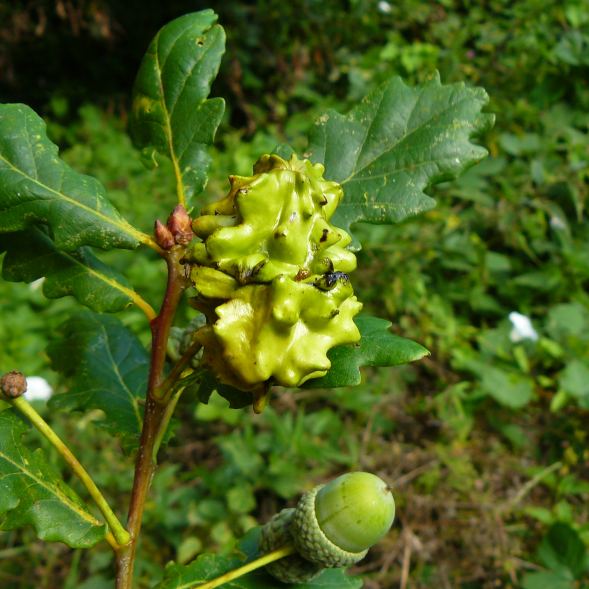
These are Knopper
Galls and are caused by a tiny gall wasp called
Andricus quercuscalicis which lays its
eggs on the tree's catkins in the spring. The abnormal
acorns develop during the summer and the acorn is
either wholly or partially replaced by the gall
growth. The acorn in my photo has been completely
transformed by the gall. The knoppers become woody and
brown in early autumn, after which they fall from the
tree and the adult sexual female gall wasp emerges
through a vent in the top of the gall in spring. The
small gall wasp has a two-phase life-cycle that
requires both Pedunculate Oak and subsequently Turkey
Oak. The Knopper Gall arrived in the UK in the 1960s
and spread rapidly, but it is not thought to have any
serious consequences for the Oak population.
OTHER
NEWS
Water
Voles in Havant
This morning Nik
Knight had brilliant views of two Water Voles feeding
and swimming in the spring and pond next to the Dophin
Centre in Park Road South in central Havant, north of
the Bosmere Junior School playing field and opposite
Tesco. Nik has had brief sightings there before and
spoke to someone who had seen them recently beside the
River Lavant and the footpath alongside
Tesco.
Bird moult
Most birds are
currently undertaking their annual moult into new
feathers which can take several weeks. This is
reflected in the rather ragged appearance of many
garden birds and the complete absence of some species.
Birds tend to hide at this time of the year to avoid
predators and territory disputes. Results from the BTO
GardenBirdwatch scheme show a pronounced late summer
and autumn trough in the reporting rate of many
species. For garden bird reporting rates go to . . .
http://bto-enews.org/NXK-1RZY4-3UEDCR-QHBLB-0/c.aspx
TUESDAY
AUGUST 27 - 2013
EMSWORTH
Emsworth
Harbour
I cycled down to the
harbour this morning to catch the tide before it got
too high. I found 122 Black-tailed Godwits off
the Thorney shore, though most of them were in water,
so could not see legs. I got two colour-ringed birds,
one a regular in Emsworth Harbour over the past 5
years and one seen only once before. Chatted with a
chap from London.
G+WR was ringed
at FM on 10Sept08 as ad male. A regular in Emsworth
Harbour ever winter since then. Total number of
sightings = 85.
L+LN - My only
other sighting of this bird in Emsworth was at Nore
Barn on 10-Nov-10. Here is today's digiscoped bird.

Brook
Meadow
Malcolm Phillips saw
the regular Water Vole by the south bridge at 13.50pm.
As he watched it swim across the river the Pike came
out from the weeds close by. He wonderd if the Pike
could take the Water Vole? Probably not an adult I
would guess, but a youngster would be vulnerable. He
got a nice photo of 2 Clouded Yellows together.
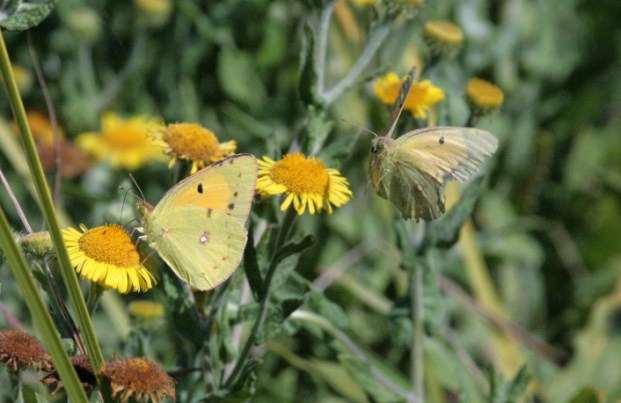
OTHER
NEWS
Clouded
Yellows
Tony Wootton had what
he thought was a good dozen Clouded Yellows on
Oxenbourne Down this morning. They certainly seem to
be having an exceptionally good year. Patrick Murphy
had his first Clouded Yellow this morning on roadside
verge opposite his house in Christopher Way. And I saw
another Clouded Yellow feeding on the track on the
west side of Thorney Island this morning.
Here
is Tony's photo of two of them at Oxenbourne
mating

Exotic
butterfly
Chris Gibbs e-mailed
me to say that he and his neighbours had great
excitement in Church Path Emsworth on Aug 25 when the
most amazing black and yellow striped butterfly turned
up in their gardens. They all rushed to try to
identify this beautiful stranger and the general
concensus was that it was a Zebra Longwing
Butterfly - Heliconius charitonia normally
resident in Florida.

I checked this name on
Google and I am sure Chris and his neighbours are
correct in their identification of this striking
insect. I read that the caterpillars of this butterfly
feed on passion flowers which are very popular in
gardens. In fact, we have some in ours which I shall
need to keep an eye on.
What a find! But how
did it come into Emsworth? Clearly it did not fly here
from Florida. The only answer is that it is an escape
from a local butterfly collection. Interestingly, the
Wikipedia entry says because of their relatively long
lifespan and their activity throughout the day, this
is a popular species with butterfly houses. The
nearest public ones are at the Chichester Butterfly
World and the Portsmouth Natural History Museum, the
latter of which which I recently visited, though I
don't recall seeing one of these there. Alternatively,
it could be an escape from a private collection.
MONDAY
AUGUST 26 - 2013
BROOK
MEADOW
Malcolm Phillips spent
two hours on Brook Meadow this morning during which he
saw a Water Vole from the south bridge at 11.50am. In
the river Malcolm spotted 4 Eels, 7 Trout and what
looks like a Pike.
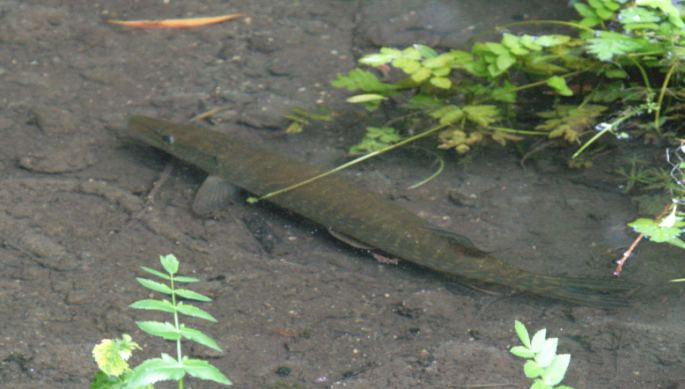
But best of all was a
fine Painted Lady butterfly - only the second
sighting this year on Brook Meadow, plus our first
Common Blue. He also saw a Small Copper and the now
regular Clouded Yellow.
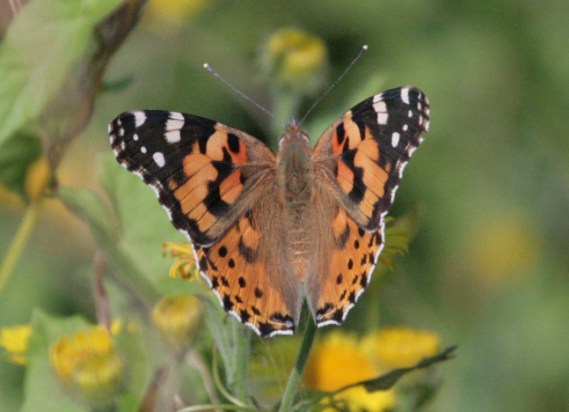
OTHER
NEWS
Missing
Mute Swans
David Minns was at
Bosham yesterday and found about 40-50 Mute Swans on
the sea north of the jetty. He wonders if thye could
be birds missing from Emsworth Millpond. That's
possible, though Bosham and Fishbourne usually have
substantial summering Mute Swan flocks of their own.
Buzzards
over Emsworth
David also two
Buzzards spiralling high up and mewing right above his
North Street house the other day. Interestingly, I
also saw two Buzzards soaring over the Emsworth
Recreation Ground this afternoon during the falconry
display in the main show area. I wondered if they had
been attracted by the flying of the falcons.
SUNDAY
AUGUST 25 - 2013
Brook
Meadow rat
Malcolm Phillips went
round the meadow for an hour this morning. Whilst
looking for the Water Vole by the south bridge a very
large Brown Rat came from under the bridge. This is
the first one he had seen in this location, though
they certainly are present in the Palmer's Road Copse
area.
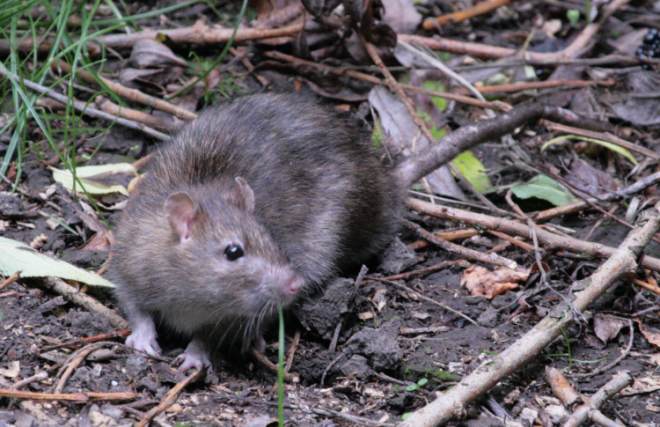
Nore
Barn Swans
Brian Lawrence had a
stroll around Nore Barn on Saturday and saw a flock of
13 swans by the stream outlet. They may be some of
those missing from the town millpond, but certainly
not all, since there are usually in the region of
50-60 on the millpond.
Warblington
birds
This morning from
6:40am to 9am, Peter Milinets-Raby had a wander around
the Warblington Church and shore (from Conigar Point
to Langstone Mill Pond). A very dull grey day, with
drizzle pushing in later. The highlights were as
follows:
Cemetery extension:
30+ Goldfinch still feeding in the wild patch, Singles
each of Willow Warbler, Chiffchaff and male Blackcap
in the bushes.
Conigar Point: 3
Lapwing, Greenshank, 52 Ringed Plovers, 7 Dunlin,
Black-tailed Godwit, 3 Common Tern.
Off Pook Lane: 17 Grey
Plover (most still in summer plumage), 4 Greenshank
(one with coloured rings RG/YY), 2 Lapwing, 4 Little
Egrets feeding on the low tide channel
Langstone Mill Pond: 6
Teal (all eclipse) - an increase in numbers! 5 Little
Egrets in the trees. Later this afternoon Peter
counted 78 Little Egrets seeing out the high tide in
the trees over the pond. An amazing sight!
Just before the
drizzle started, an impressive hirundine flock was
pushed down out of the sky and they all flew about
above the pond and trees for 20 minutes before moving
on. An amazing sight, one lady was thrilled to have
the birds swooping down around her head, listening to
their contact notes and the swish of their wings! The
flock consisted of 70+ Sand Martins, 30+ House Martins
and 20+ Swallows. Other groups of Swallows were
observed moving south throughout my walk (flocks of
17, 12, 5, 9 and 14).
This lunchtime Peter
was cleaning the algae out of his medium sized pond in
his Havant garden when he discovered three baby newts.
He would like help in their identification. My guess
is that the dark one is probably older than the pale
one.
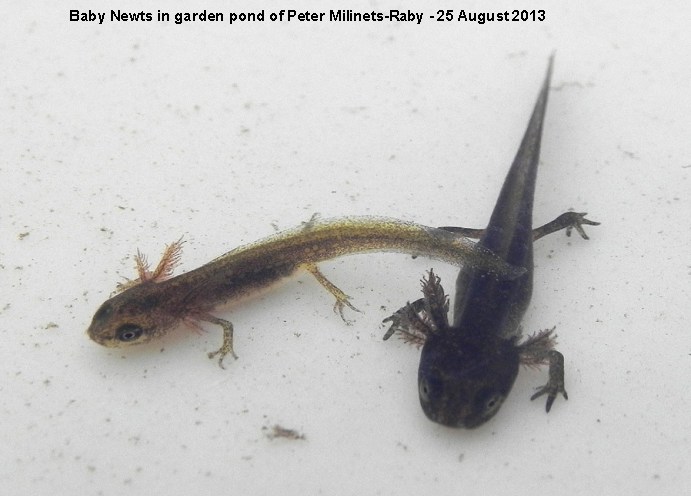
SATURDAY
AUGUST 24 - 2013
Shells
on the shore
Ralph Hollins provided
the following information about Juliet Walker's
discovery of a wreck of hundreds of small shell fish
on the shoreline on Hayling Island as reported in
yesterday's blog.

They were not (as I
naively thought) Whelks, but rather Laver Spire Shells
(Hydrobia ulvae) which, Ralph says, are
probably the most numerous mollusc in our harbour mud.
For more about these sea snails go to . . .
http://www.arkive.org/laver-spire-shell/hydrobia-ulvae/
This site
says that the shells normally measure only 4 to 6 mm;
Common Whelks are considerably larger - up to 8 cm. It
also says that they breed in both summer and autumn
(so they might have gathering to mate) and that
clusters of apparently dead shells can sometimes be
revived when the tide comes in.
The
hovering hoverfly
Ralph Hollins also
provided the identification of the hoverflies in the
photo on yesterday's blog as Drone Flies
(Eristalis tenax). The general build and
the thin 'gold' rings around the abdomen were
distinctive.
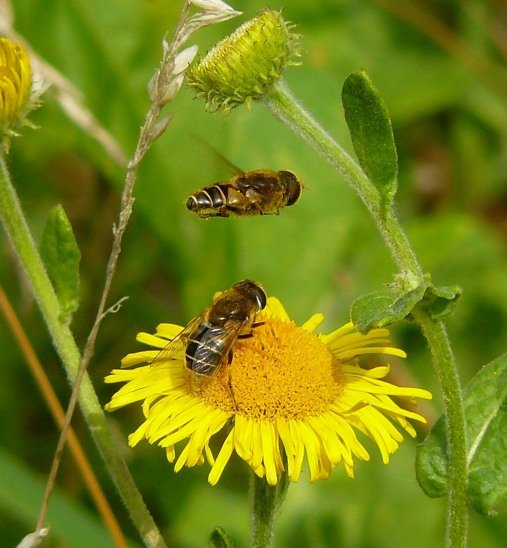
Checking Wikipedia,
Ralph was amused to find a picture of a pair of these
hoverflies actually mating on a flower and wonders if
my photo of one hovering while the other fed indicates
the males of this species have the good manners to
wait till they have finished eating before attempting
to mate! See . . . http://en.wikipedia.org/wiki/Eristalis_tenax
Red-tailed
Woodpigeon?
Peter Mitchell sent me
the following photo from his kitchen window on Hayling
Island of what could be a new species known to
science. Has anyone seen anything like this oddly
coloured Woodpigeon? Peter assures me it was a simple
compact shot with no use of Photoshop or similar.
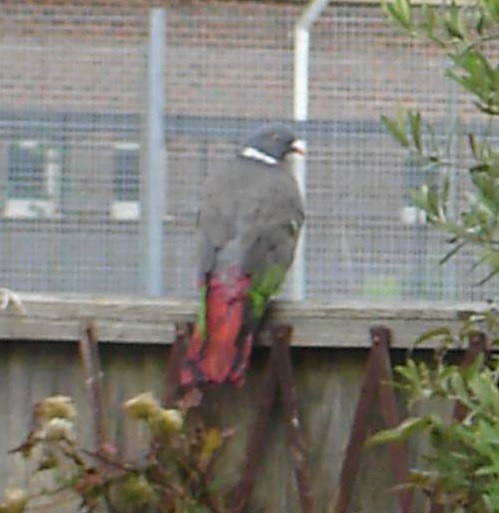
FRIDAY
AUGUST 23 - 2013
BROOK
MEADOW
Small
Copper
I saw a Small Copper
butterfly for the first time on Brook Meadow since Jul
31. It is uncommon on Brook Meadow, but recorded in
most years. This one was probably one of the second
(August) brood. After warm summers they sometimes have
third or even fourth broods in the south, so we might
be seeing them for a while.

Clouded
Yellow
The Clouded Yellow
is still feeding on the Lumley area. This was our
4th sighting this year, probably all of the same
individual. Otherwise all butterflies were whites, but
for the odd Gatekeeper.
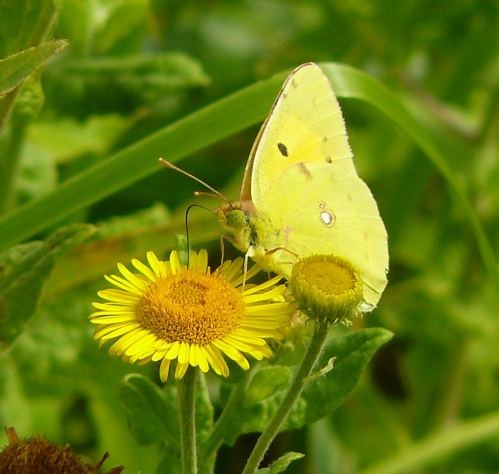
Hoverfly
behaviour
While I was on the
orchid area of the north meadow, I was interested to
watch one hoverfly hovering over another hoverfly
which was feeding on a Common Fleabane flower. The
flying fly pursued the feeding fly as it moved from
one flower to another for several minutes. I have
never seen this behaviour before, which I assume was
preparatory to mating. They did not mate while I was
there. I am not sure of the species.

Short-winged
Conehead
In the same area as
the hoverflies I spotted a Short-winged Conehead
resting on a Common Fleabane flower. It was bright
green with a dark stripe down its body and extremely
long antennae. It was a female insects having a long
ovipositor.
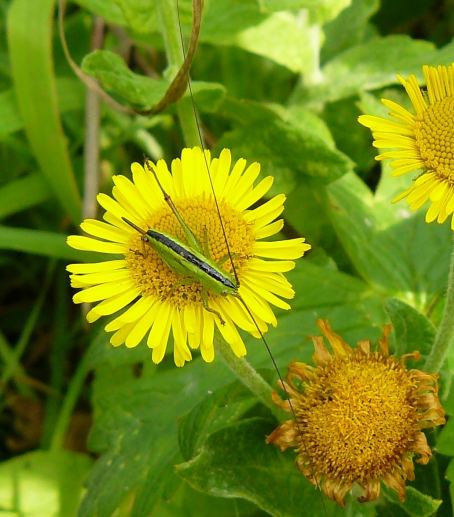
Blue
Water Speedwell
There is a good
flowering of the hybrid Blue Water Speedwell
(Veronica x Lackschewitzii) with long flowering
spikes on the west bank of the river just north of the
observation fence. It is best seen from the main path
on the east side of the river. I have found this plant
in several areas of the meadow this year.
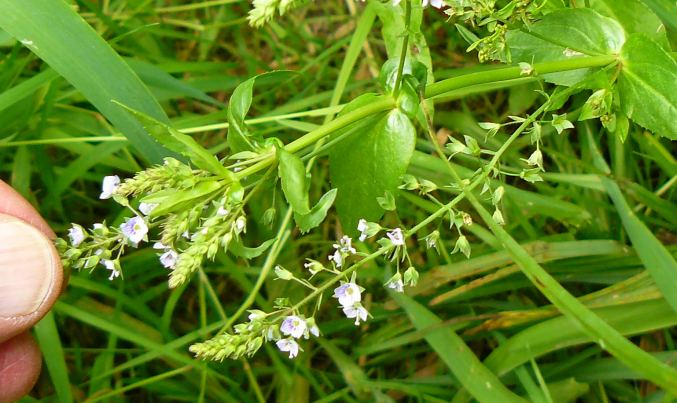
Alder
Tongue gall - Taphrina alni
Ralph Hollins drew my
attention to a strange 'fungal gall' called Taphrina
alni (sometimes called Tongues of Fire) that grows on
the young green female cones of Alder trees. See
Ralph's diary for Mon 19 Aug. I decided to have a look
at the Alders on the west bank of the River Ems in
Palmer's Road Copse on Brook Meadow and found several
cones that were affected by this gall which grows from
the cones on tongue-like fashion. All the galls I
found were either yellow-green or brown and
shrivelled, as shown in this photo, though apparently
the galls are often bright red.
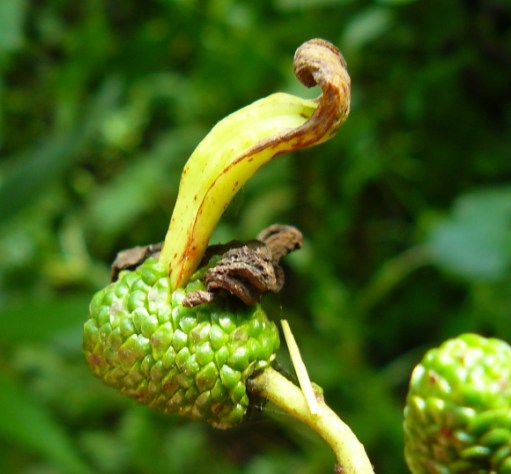
The following web site
show photos of red ones. http://www.rxwildlife.info/storage/IMG_4997.JPG
According to Wikipedia this gall was rare in the
United Kingdom and is absent from many of the
published gall keys, though is becoming more common.
Birds
Peter Milinets-Raby
was also on Brook Meadow today and saw a Coal Tit
again, plus 2 to 4 Chiffchaff (by tunnel and by
cottage by pond), 1 female and 2 male Blackcaps (by
tunnel and along east edge), Two young Robins by the
tunnel, Green Woodpecker and Great Spotted Woodpecker.
Two small flocks of House Martins flew over south (5
and 7).
WARBLINGTON
- LANGSTONE
Peter Milinets-Raby
was out this morning at 6:30am until 9:10am to walk
along the Warblington shore to the Langstone Mill
Pond. The highlights were as follows: Yellow Wagtail
over, plus Meadow Pipit, 3 male and 2 female
Blackcaps, plus 4 Chiffchaff in the bushes at the end
of the new cemetery extension. 40+ Goldfinch feeding
in the wild patch there - very spectacular.
Off Conigar Point: 2 Whimbrel, 3 Common Tern, 5 Little
Egrets feeding together,
Off Pook Lane: 19 Grey Plover (Most in summer
plumage), 13 Greenshank (two with coloured rings LR/NL
and NR/RO - both different birds from he other day!),
Black-headed Gull with yellow ring on its left leg
'2BAS'.
Langstone Mill Pond: Kingfisher, 3 Teal (eclipse), 9
Little Egrets hanging around, 5 Swallows
over.
OTHER
NEWS
Whelks
on the shore
Juliet Walker was
walking round Sandy Point at Hayling Island as the
tide was going down yesterday afternoon. The shore all
round the lagoon was speckled with what she at first
thought might have been seeds or even man-made jetsam,
but on closer inspection she realised they were, in
fact, small shells, probably whelks. Juliet asks, Is
this usual during the breeding season? Would they
survive the hot sun until the next tide, particularly
the ones which had not clamped themselves on to
anything? I don't know the answers to these questions.
Can anyone help?

WEDNESDAY
AUGUST 21 - 2013
EMSWORTH
Swan
decline on millpond
Walking around the
town millpond these days one cannot help but be aware
of the almost complete absence of Mute Swans, apart
from the pair with their one cygnet that nested near
the bridge. There was just one other lone individual
when I went round this morning. In fact, the regular
flock has been missing since early spring. I have been
doing counts of the swans on the millpond since the
early 1990s and have never known numbers as low as
this. In the early 2000s the August moulting flock was
regularly over 100 birds. So, what has happened?
The decline started
with the establishment of the swan nest and the
territorial patrols of the cob. Several times I
witnessed the cob chasing and sometimes attacking
other swans on the millpond, even some way from the
nest. Clearly, this could have produced a movement of
the swan flock away from the millpond. Where they have
gone to I have no idea, but Thorney Deeps is a
possibility. Incidentally, the once scraggy cygnet
from the 'litter nest' is now growing well and looking
good.
Clouded
Yellow with open wings
Brian Lawrence had the
good fortune to snap a Clouded Yellow on Brook Meadow,
with its wings open, a most unusual occurrence. This
is the third sighting of Clouded Yellow on Brook
Meadow this week, probably all of the same individual.
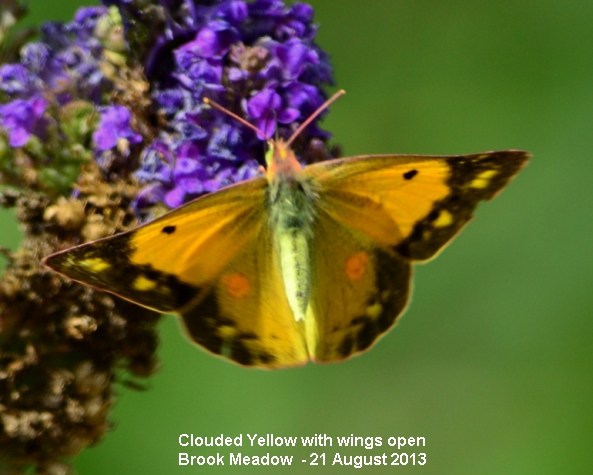
TUESDAY
AUGUST 20 - 2013
BROOK
MEADOW
I had a walk through
the meadow this morning. I checked the recently
planted Oaks on the Seagull Lane patch which all
looked fine. The Hoary Ragwort is now in full
flower on the orchid area, much as it has been in the
past few years.

Plenty of white
butterflies were on the Common Fleabane, but there's
still no sign of any Common Blues.
I happened to meet Ros
Norton near the Lumley gate who was on a walk with the
Petersfield group. Next, I came across Malcolm
Phillips who was peering intently down at the river
from the south bridge with his long lensed camera. We
had a look together, but did not see anything of the
possible Water Shrew that Malcolm saw here yesterday.
However, we did see a fine Brown Trout and an Eel
swimming in the river. Malcolm got this rather
nice image of the Eel swimming near the surface.
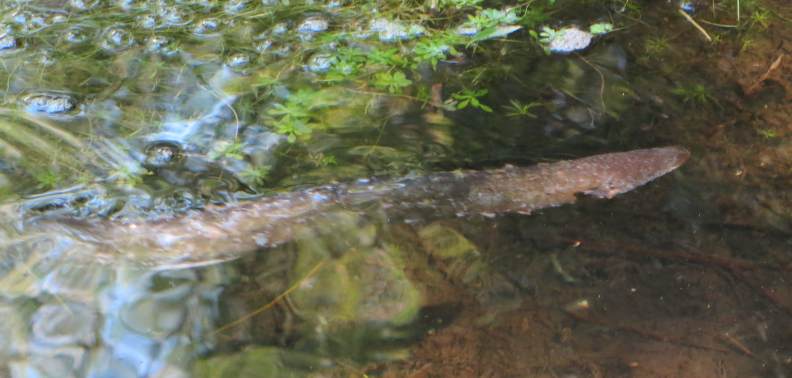
Peter's
news
Peter Milinets-Raby
visited Brook Meadow today and saw a good variety of
birds, including Swifts, Swallows and House Martins
flying over and a Buzzard very high in the sky. He
also saw at least 2 Chiffchaff, a male Blackcap and a
Whitethroat; these are summer visitors which probably
bred on the meadow. He saw lots of butterflies, but 2
Clouded Yellows were very special. It looks as if they
are having a good year. Peter also got photos of what
are almost certainly Meadow Grasshoppers. Here
is one distinguished by the absence of hind wings.
Meadow Grasshoppers are the only flightless
grasshopper in Britain and are very common on Brook
Meadow.

OTHER
NEWS
Butterflies
Patrick Murphy did
some butterfly watching in his garden today. On the
Buddleja flowers he saw lots of Whites (small and
large) plus a Brimstone and a Small Tortoiseshell. The
latter 2 spent over an hour feeding on the Buddleia
florets. This is Patrick's photo of a male Brimstone
typically with wings closed, showing its yellow
underwings with a brown spot and its pink antennae.
This will be one of the newly emerged adults that will
be gorging themselves on nectar for the next two
months or so in preparation for hibernation. They will
re-emerge on the first warm days of spring and roam in
search of mates and egg-laying sites on Buckthorn
bushes of which there are many on Brook Meadow.
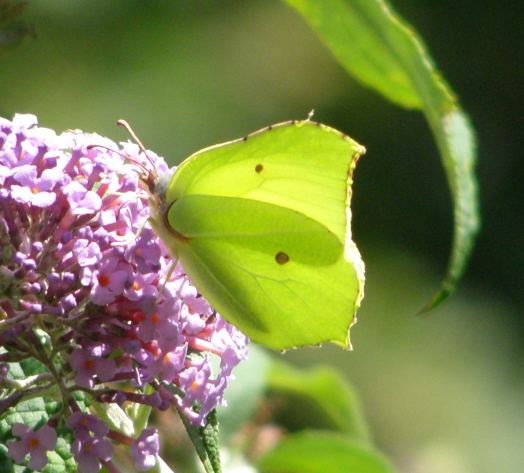
Thorney
Island
I happened to meet Ros
Norton near the Lumley gate this morning who was on a
walk with the Petersfield group to Thorney. Tony
Wootton sent me a few photos of their sightings on the
Deeps seawall, including this Bloody-nosed
Beetle (without blood) on Ros's hand. It only
extrudes blood when alarmed, so clearly it felt quite
safe in Ros's hand.
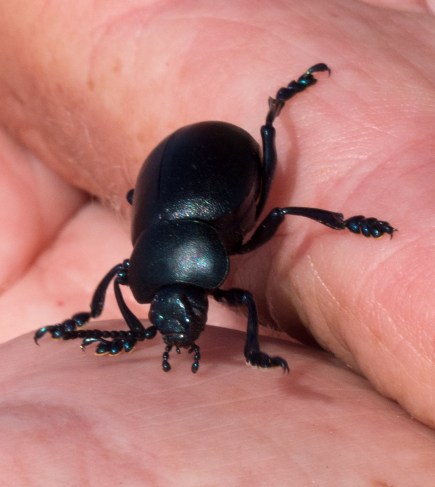
Thony also sent this
rather fine first winter Wheatear which will be
on its way to its wintering quarters in Tropical
Africa.

MONDAY
AUGUST 19 - 2013
BROOK
MEADOW
Purple
Loosestrife is in flower on the river bank south
of the north bridge, as in previous years. The only
other place it flowers on Brook Meadow is north of the
south bridge, though there is a good crop in the
garden of the neighbouring Gooseberry Cottage.

There is no sign of
any Bulrush flowers this year on the west bank
north of the observation fence. I think they must have
been crowded out by the dominant Branched Bur-reed
which have now spread along that river bank.
Malcolm's
news
Malcolm Phillips was
on the meadow for about 2 hours today during which he
saw the Water Vole again from the south bridge at
2.30pm. Malcolm spent about half an hour watching a
very small creature swimming out from the bank and
then back into the vegetation, but just could not get
any sort of photo. He thought it was no more than 3ins
long.
That sounds like a
Water Shrew to me, which we have seen on several
occasions in the past, but they are very difficult to
photograph (or even to see) due to their very small
size and fast swimming. Here is a photo of a Water
Shrew that I took from the internet showing its
typically pointed face.
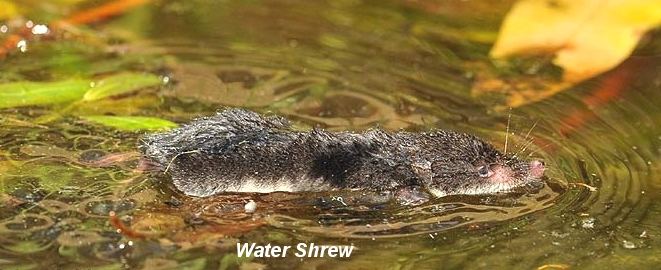
RAILWAY
WAYSIDE
I had a mooch around
on the new Emsworth Railway Wayside to the north of
the station. Although we had a good crop of Marsh
Woundwort, Common Knapweed and Common Toadflax again
at the eastern end of the site, there has been another
serious invasion of Brambles at ground level. This
area needs to be cleared again once the plant seeds
have fallen otherwise we are likely to lose these
plants in future years. Interestingly, there is no
sign of the Redshank that was so abundant on the mound
at the eastern end of the site last year, nor any sign
of the Marsh Cudweed that we found here last year.
I looked for some of
the rarer plants that we found last year, such as,
Sharp-leaved Fluellen, Small Toadflax and
Small-flowered Crane's-bill, but there was no sign of
them this year. The embankment, in particular, has now
been taken over by large dominant plants, such as Wild
Carrot, Bristly Ox-tongue and Spear Thistle, leaving
no room for the more delicate plants that flourished
here last year. However, I have recorded some new
plants this year taking the total for 2013 to 129
compared with 123 last year.
The site remains a
good source of nectar for insects. Today I saw several
Common Blues, males and females plus a single Clouded
Yellow, which is a first for the site.
Here
is one of the male Common Blues feeding on Common
Fleabane
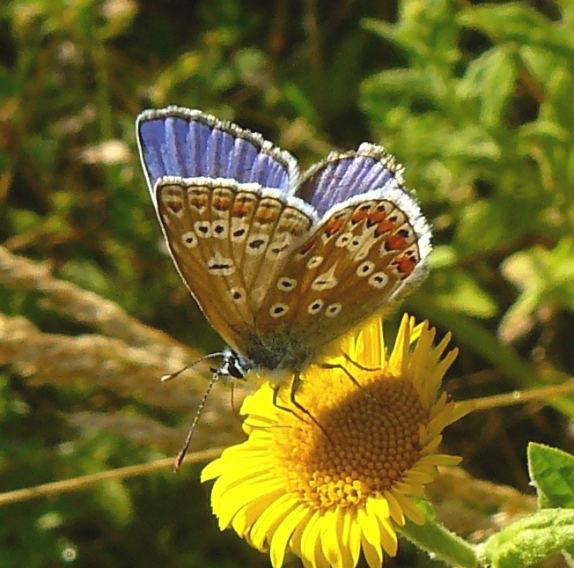
and
here is the Clouded Yellow typically with wings closed
on bare rocky ground
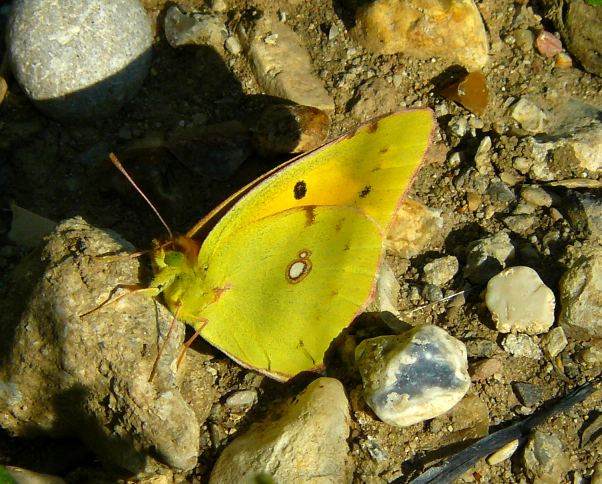
OTHER
NEWS
Bee
chewing flower
While gardening Tony
Wootton spotted a bee on his neighbours runner beans.
It never tried to enter the flower by the usual route,
but always persisted in biting/chewing in from behind.
This is well known behaviour of some bees that are
unable to get to the flower's nectar source by the
normal route. However, I have not seen a photo of one
doing it before. Well done, Tony.

Little
Owl on Hayling
Charlie Annalls was
thrilled to catch her first ever glimpse of a Little
Owl yesterday in the early evening along the Hayling
Billy Line. She had been walking that trail for years
and not seen one before. I agree the bird looks like a
juvenile as it lacks the adult's spotty head and
striped chest. Charlie was about 300-400metres away
when she took this photo, but it shows the bird quite
clearly. Nice one, Charlie.

SUNDAY
AUGUST 18 - 2013
BROOK
MEADOW
I had a stroll around
the meadow this afternoon for the first time after a
week's holiday in Somerset. Scroll down to a brief
report of my wildlife observations on holiday with
photos at the end of this day's entry.
The meadow is looking
good as usual with a fresh growth of grasses in the
recently cut areas. Amphibious Bistort is an
abundant plant on Brook Meadow, but rarely flowers.
However, I found no less than five flowering plants
all climbing through the tall Michaelmas Daisies on
the east side of the Lumley area near the stream.
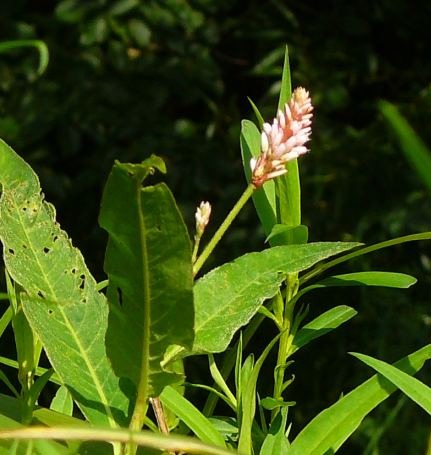
Pepper-saxifrage
is also flowering in the usual spot on the east side
of the Lumley area.
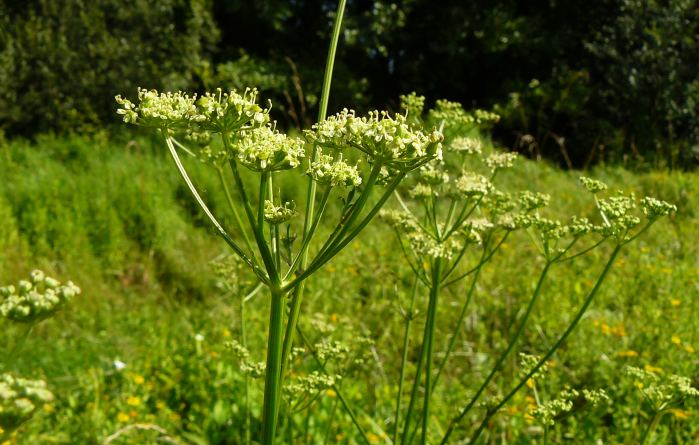
Malcolm's
sightings
Malcolm Phillips had
some good sightings on the meadow yesterday. He
spotted this small moth with red-brown wings and
yellow patches called Pyrausta aurata.
This moth has been recorded before on Brook Meadow but
this was a first sighting this year. I previously saw
and photographed one in Stansted Forest on Aug 3.
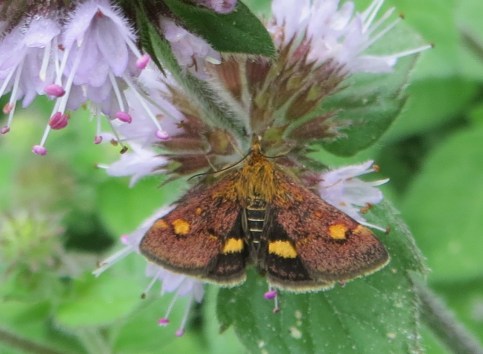
Malcolm also got this
image of a very attractive fungus which I am
tentatively identifying as Marasmius
rotula - Its official common name is Collared
Parachute after the cap which is white and ribbed like
a parachute.
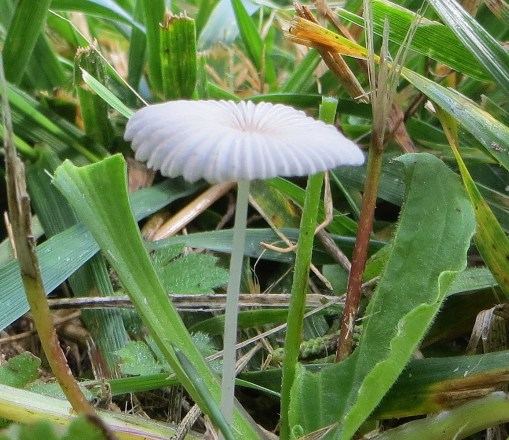
Malcolm also saw his
regular Water Vole near the south bridge.
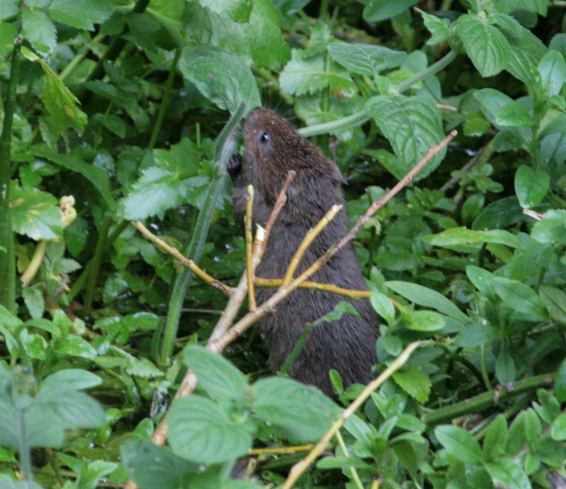
Water
Vole burrows
I was away on holiday
last week, so missed a TV programme showing Water
Voles behaving 'naturally' inside their burrows.
However, Ralph Hollins provided the following useful
information with the link to watching the relevant
bits on the Iplayer.
The programme was on
BBC 2 last Friday at 9pm and there will be further
episodes on Friday nights (next on Aug 23). For the
series the BBC have constructed artificial burrows for
Rabbits, Badgers and Water Voles with a glass wall
allowing the cameras to see what is going on in each
of the many underground chambers. The chambers have
small LED lights sufficient to get good pictures
without disturbing the animals. The presenter is Chris
Packham assisted by experts in the animal species. If
you want to minimise the time spent watching (only
seeing the Vole sections) go to http://www.bbc.co.uk/programmes/b038p45r
and start the programme then skip in for 15.00 minutes
to watch the section on construction of the Vole
burrow and introducing two Voles (the male is a
southerner but the blacker coated female came from
Scotland). When you have seen enough of that skip to
47 minutes 30 seconds to see the Voles settled in the
burrow and eventually mating (you have to wait till
next week for the birth). Amongst other things the
programme showed that the Voles dig their tunnels
using their teeth as pickaxes and only use their feet
to move the earth detached by the teeth out of the
way.
Warblington
birds
Peter Milinets-Raby
had an early morning walk around Warblington (6:38am
to 9:17am). The highlights were as follows: Peregrine
hunting over the church and later over the mud flats.
20+ Swallows hawking over the field by the barn. 2
Chiffchaff, Willow Warbler and male Blackcap in the
bushes by the Ibis Field. 30+ Goldfinch flock feeding
on the wild flower patch at the far end of the new
cemetery extension. Juvenile Green Woodpecker doing
some historical research in the cemetery reading grave
stones!

Conigar Point: Just as
the tide was pushing in, so waders starting to gather
before flying off to roost. 6 Lapwing 11 Grey Plover,
3 Dunlin, 13 Ringed Plover, Whimbrel, Bar-tailed
Godwit, 3 Greenshank (one with rings RW/B-TagY), 63
Oystercatcher, 46 Curlew, Adult winter Med Gull, 3
Common Tern.
Pook Lane: 117
Redshank together before departing for their high tide
roost. 7 Greenshank (two with rings RG/YY and the
second bird was incomplete ??/RY),
Langstone Mill Pond:
Kingfisher heard, but not seen, Reed Warbler moving
through the reeds, 27 Little Egrets hanging around
(all nests are now empty), 4 Grey Herons with the
egrets, A Moorhen has two tiny chicks (just days
old!!)
SOMERSET
HOLIDAY
SOMERSET
LEVELS
Jean and I visited two
or the nature reserves on the Somerset Levels during
our short holiday in this beautiful area. Both
reserves were in a similar habitat with extensive
reedbeds and stretches of open water which attract
migrant birds in winter.
We visited Ham Wall
on Aug 13 - a RSPB reserve near Glastonbury. We
did what is called the Ham Wall loop, walking up one
side of the Glastonbury Canal and back the other side.
We then visited Westhay Moor on Aug 16 - a
Somerset Wildlife Trust reserve and very impressive it
was too with well laid out routes and good hides with
views over the reedbeds and open water.
Here
is a view from the Westhay Moor reserve, looking
across to the Mendips
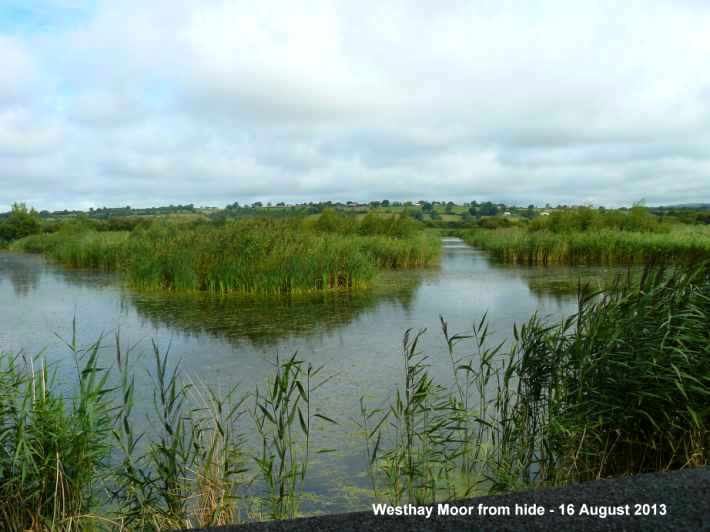
Birds
This is not a good
time of the year for birdwatching and we saw very few
birds of any interest. Moorhen, Mallard and Mute Swan
were common on the lakes. We also saw Cormorant,
Little Egret (2) and a Buzzard flying over. From one
of the observation areas at Ham Wall we could see
Lapwing and Black-tailed Godwits out on the
open water area. A local birder with scope said one of
the godwits had colour rings with red on the left and
green over white on the right, but I got no more
information. It could have been a Farlington ringed
bird, though there are several with GR on the right.
Ham Wall was where
Tony and Hilary Wootton heard a Bittern booming
on their visit in May, but we are too late for them. I
was surprised to see a special information board about
Little Bitterns breeding on the marshes and a look out
area marked out. On Westhay Moor we passed an
interesting old log with lots of carved Starlings on
its branches. This is the prime area for seeing the
spectacular gatherings of Starlings going to
roost in winter.
Plants
I noticed a number of
interesting plants during the walks, including four
which were new to me. These were:
Frogbit - quite
abundant in the water and looked like a small water
lily with round leaves and white flowers with a basal
yellow spot. It got its name from the belief by
classical Greeks that it was eaten by frogs.
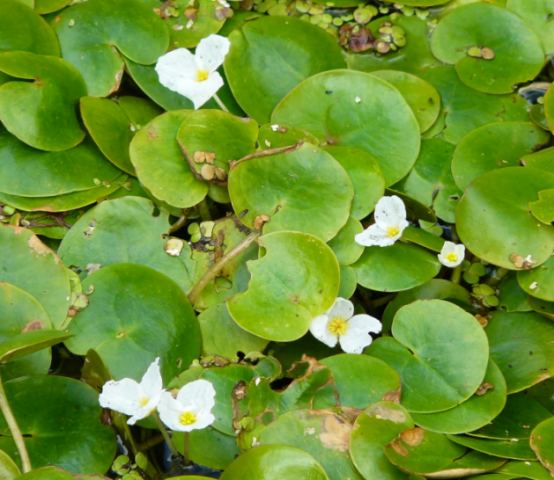
Greater
Bladderwort - one of two yellow flowered plants
growing in the lakes. This is an insectivorous plant,
catching insects in its underwater bladders. It had
straight reddish stems rising from the surface of the
water and bright yellow flowers at the top of the
stems. I think the round leaves are those of Frogbit.
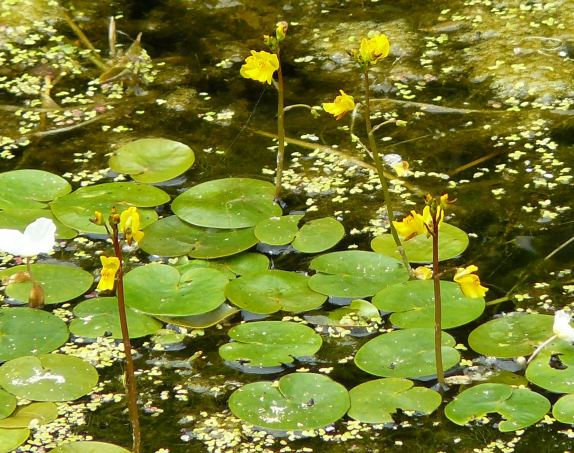
Yellow Water
Lily - the other yellow flowers which were much
larger than the Bladderwort projecting out of the
water on thick stems.

Greater
Chickweed - prominent in patches around the
reserves. It looked like an over large Common
Chickweed. It had distinctive red stamens - 10 of
them.
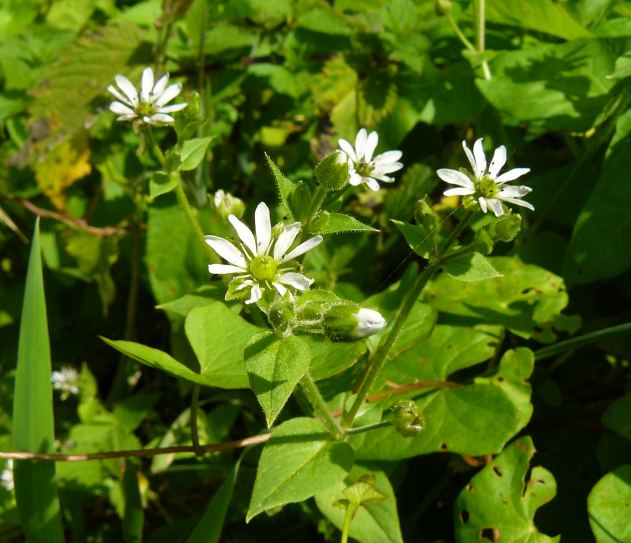
Other plants of
interest included Marsh Woundwort, Purple Loosestrife,
Gipsywort, Common Valerian, Redshank, Heather,
Tormentil, Greater Bird's-foot Trefoil, Marestail,
Soft Rush and Blackberries galore.
Insects
Small
Tortoiseshells were abundant along the main tracks
on both reserves, by far the most numerous butterfly
we saw. Just another indication of how this butterfly
has recovered. Others seen were Speckled Wood,
Peacock, Red Admiral, Large White, Small White,
Green-veined White, Brimstone (male).
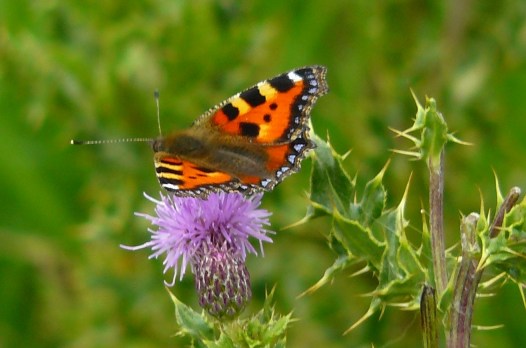
There were lots of
mainly blue damselflies around the lakes and some
large dragonflies. I identified Southern Hawker
(immature) and Common Darter (male).
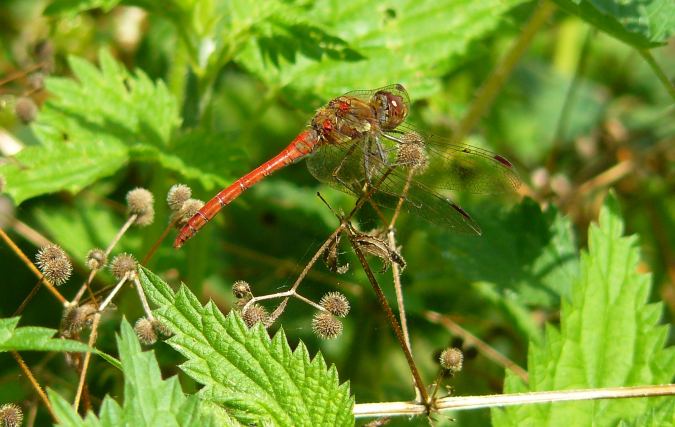
EBBOR
GORGE
We drove onto to top
of Ebbor Gorge where we stopped for a short walk into
Cooks Field Nature Reserve on the Mendips with
glorious views across the valleys. Three species of
thistle were in flower. The deep red flowers of Dwarf
Thistles were attracting Bumblebees. I snapped what I
think was a male Bombus pratorum,
red-tailed with two yellow bands and yellow hairs on
its face. Patches of flowering Creeping Thistles
attracted several Small Tortoiseshells. There were
also tall Marsh Thistles.

FRIDAY
AUGUST 9 - 2013
BROOK
MEADOW
Water
Vole
Malcolm Phillips went
twice round the meadow today. On his first round he
saw a Water Vole at 10.55am just down from the deep
water sign in Palmer's Road Copse.
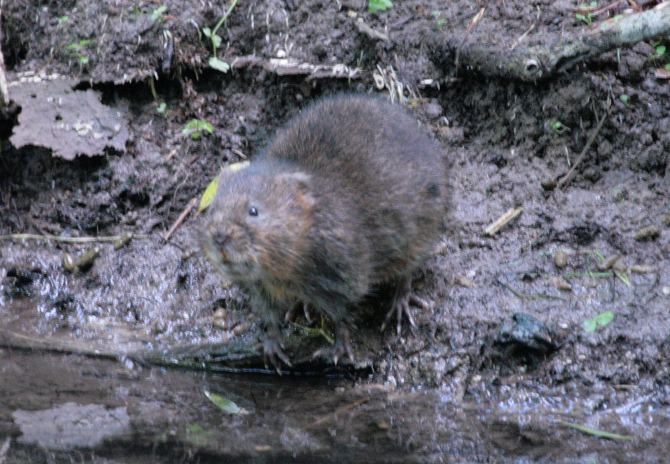
Clouded
Yellow
More significantly,
Malcolm got the following photo of a Clouded Yellow
feeding on Common Fleabane. Malcolm said he had not
seen one before, which is not surprising since Clouded
Yellow is a very rare butterfly on Brook Meadow. This
was only the third sighting on Brook Meadow since
records began in Year 2000. I recall seeing one flying
over the Lumley area last year on Sep 4, but it did
not stop for a photo. Malcolm apologised for not
getting a photo of the butterfly with its wings open.
This is not surprising since Clouded Yellow hardly
ever opens its wings when settled.
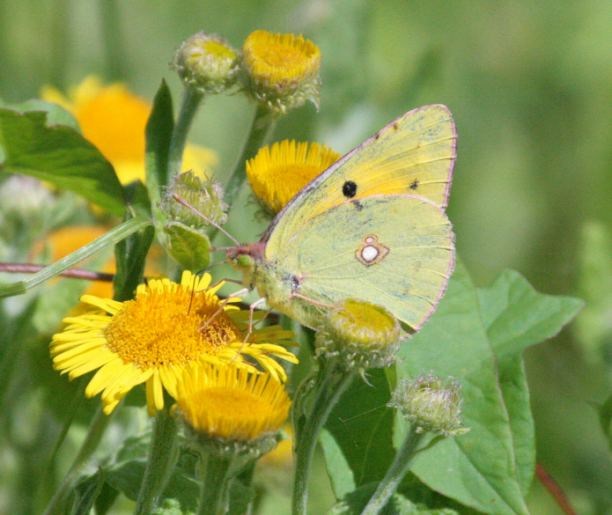
OTHER
NEWS
Mistle
Thrushes
Caroline and Ray
French came across a very large flock of 52 Mistle
Thrushes feeding on the pasture between Lumley Wood
and North Coopers Wood (approx. SU 760 106) at 10.30
yesterday. "As we walked on up the track, past the
cottage, in the direction of Lordington Copse we came
across another dozen or so roosting in one of the
trees. These may well have been part of the original
52 that we had seen feeding on the ground, although we
didn't actually see them fly into the tree so they
could also be additional birds. This is by far the
biggest flock I have ever come across. Before I read
it on Ralph's webpage recently I had been unaware of
their habit of summer flocking."
Interestingly, there
have also been reports on Hoslist of large gatherings
of Mistle Thrushes, but not in the numbers seen by
Caroline and Ray. John Clark expects to see quite
large aggregations of family parties at this time of
year.
THURSDAY
AUGUST 8 - 2013
STANSTED
Jean and I had coffee
in the Pavilion Cafe and then had a walk around the
Dutch Garden right next door. I love the aroma of this
garden. But more so I love the myriads of insects that
are attracted to the smelly flowers. Today, the
Buddleias were covered with butterflies, including
Large White, Small White, Peacock, Comma, Red Admiral,
Small Tortoiseshell, plus one Silver-washed
Fritillary. I was hoping for Painted Lady, but no such
luck.
Here
is a female Large White with very prominent black
spots and pale yellow underwings.

Here
is the Silver-washed Fritillary on the white flowered
Buddleja
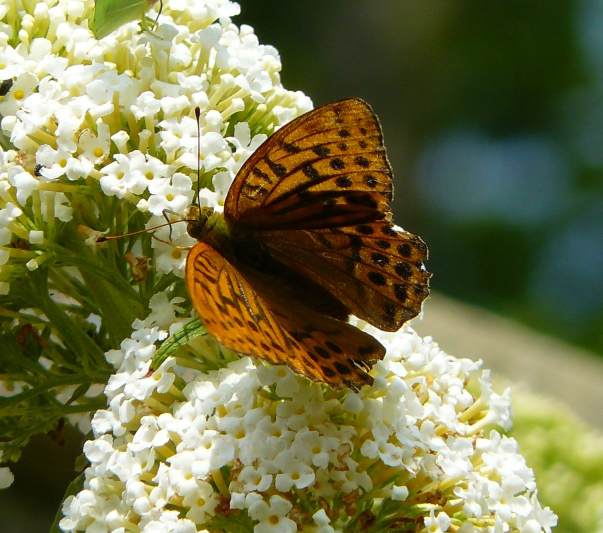
Meanwhile the low
growing herbs were covered with hundreds of mainly
white-tailed Bumblebees. I think I found both Bombus
terrestris (two yellow bands with dark face) and
male Bombus lucorum (yellow bands with yellow
face).

I also found a small
moth Pyrausta aurata with red wings and yellow
patches which I have seen many times
before.

A male Common Darter
and a pair of Azure Damselflies were around the Lily
pond. We also walked around the arboretum where I
added a male Brimstone to the list of butterflies.
BROOK
MEADOW
Bumblebees
I had a amble around
the meadow this afternoon where I found several ginger
Bumblebees Bombus pascuorum feeding on
the flowers of Lesser Burdock on the Seagull Lane
patch
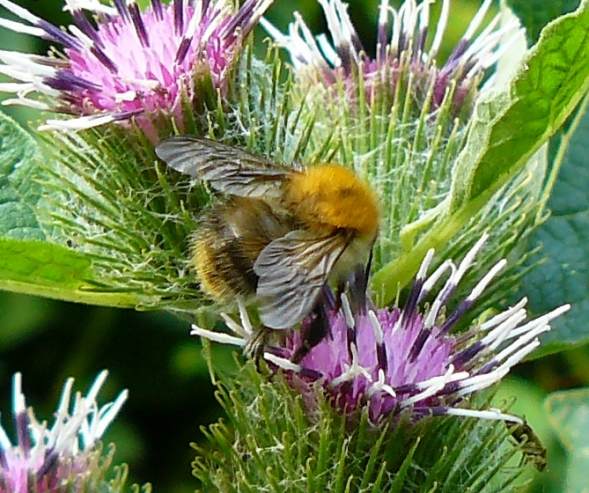
I found red-tailed
Bumblebees Bombus lapidarius feeding on
Common Fleabane. I wonder if this indicates a
preference?
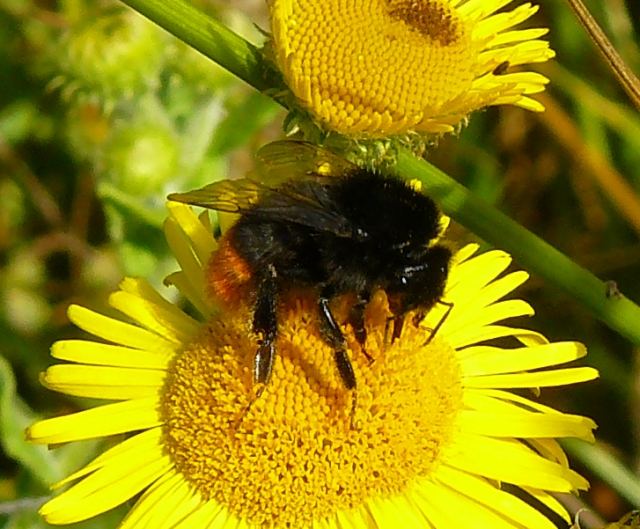
Water
Voles
Malcolm Phillips had
two more sightings of Water Voles on the river in
Palmer's Road Copse today. The first one was just up
from the south bridge at 10.20am. The second was just
south of the deep water sign at 1.30pm.
Here
is Malcolm's photo showing the vole swimming through a
jungle of Fool's Water-cress in the river beneath the
south bridge
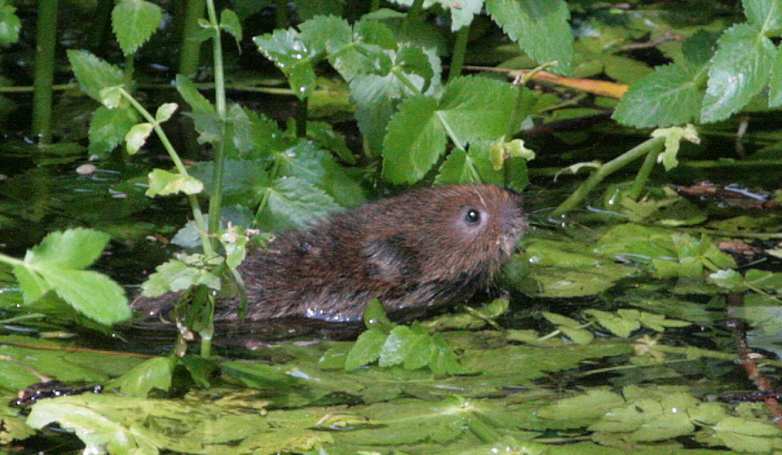
Privet
Hawkmoth larva
Chris Oakley visited
Brook Meadow last week on one of those scorching hot
days so there was not a lot to be seen apart from
butterflies, bees and hoverflies. However, he did find
a dead caterpillar of the Privet Hawkmoth which
appeared to have been trodden on. One can just make
out the seven white and pink stripes on the sides of
the larva at the top of the photo. These distinguish
the Privet Hawkmoth from the caterpillars of other
Hawkmoths. As far as I am aware this is the first
Privet Hawkmoth recorded on Brook Meadow.
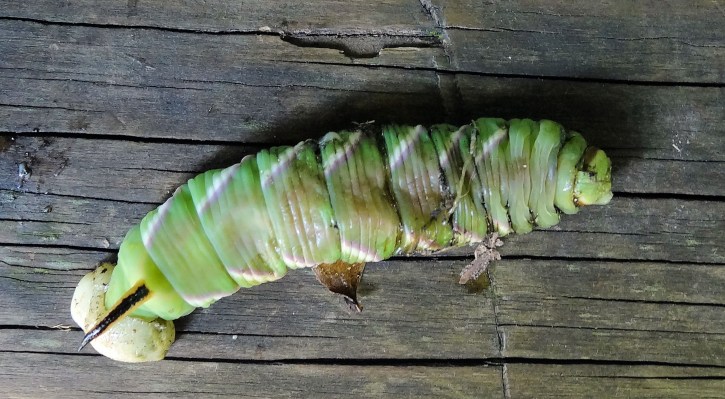
WEDNESDAY
AUGUST 7 - 2013
BROOK
MEADOW
I went for my regular
morning walk through Brook Meadow and down to the
Hermitage Millponds. The Seagull Lane patch is
currently a blaze of colour from the multitude of wild
flowers that flourish there. They include Mugwort,
Teasel, Hogweed, Large Bindweed, Spear Thistle and
Stone Parsley with a few bright pink flowers of
Broad-leaved Everlasting-pea thrown into the mix.
Stone Parsley with tiny white flowers seems to have
done very well everywhere this year. A bush of Lemon
Balm is flowering near the metal gate to this area for
the first time in my memory. Blackberries are now
ripening on the Brambles on the north path - the
Himalayan variety which are large and juicy.
Here
is a cracking Speckled Wood that I got resting on the
leaf of Hogweed
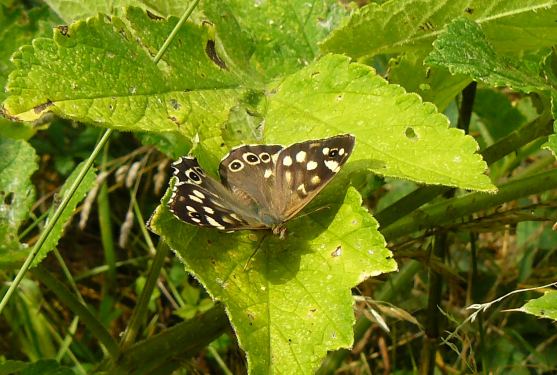
Elsewhere on the
meadow, Hemp Agrimony and Hoary Ragwort are in
flower on the orchid area and Common Fleabane abounds
on the Lumley area along with the emerging umbels
of Wild Angelica.
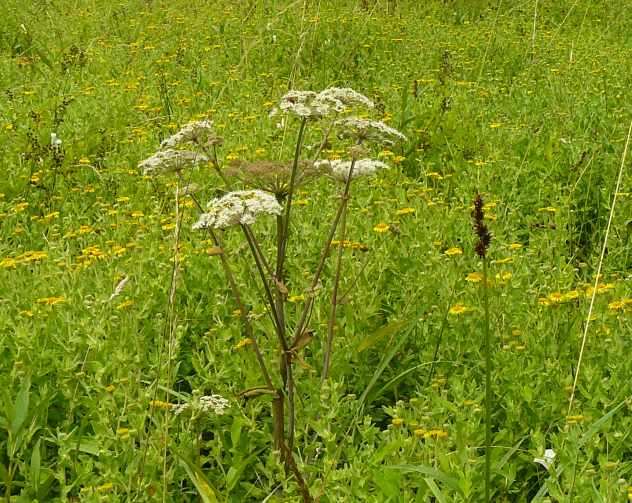
There are some spikes
of False Fox Sedge on the far side of the Lumley area
among the Michaelmas Daisies which stand some 6 feet
tall (180cm). I have never come across them that tall
before. Francis Rose gives the limit as 100cm in his
book on Grasses, Sedges and Rushes.
There is a fine crop
of berries on the Rowan plantation that was
planted on the east side of the north meadow in 2005
in memory of the late Gwynne Johnson. Gwynne was a
very good friend of Brook Meadow and personally was an
inspiration to me in the identification of flowers and
grasses. I think Gwynne would have appreciated these
berries. I wonder if they will attract Waxwings?
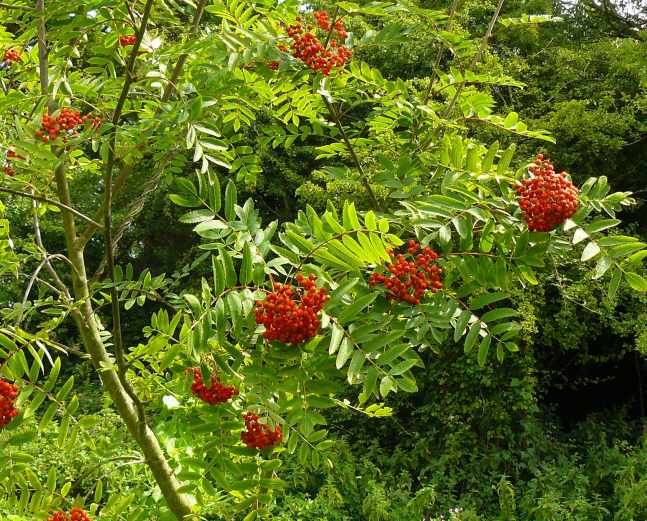
Malcolm Phillips had
two Water Vole sightings today, possibly of the
same animal, north of the south bridge. Malcolm got
this very good image from one of the sightings.
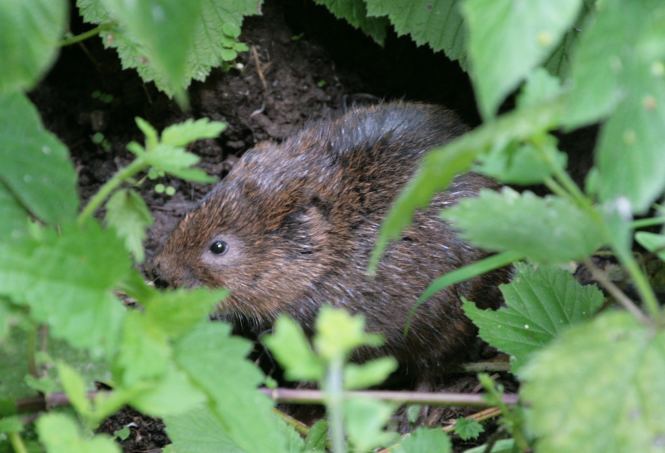
MILLPOND
NEWS
All is quiet and
peaceful on Slipper Millpond now the Great
Black-backed Gulls have left with their three
youngsters. The Mute Swan family that nested on Peter
Pond swim quietly around the pond with their one
remaining cygnet while the Coots scuttle around in
their busy fashion with the occasional skirmishes when
they get too close. Cormorants are also back on the
centre raft which will be their home for the winter
period.
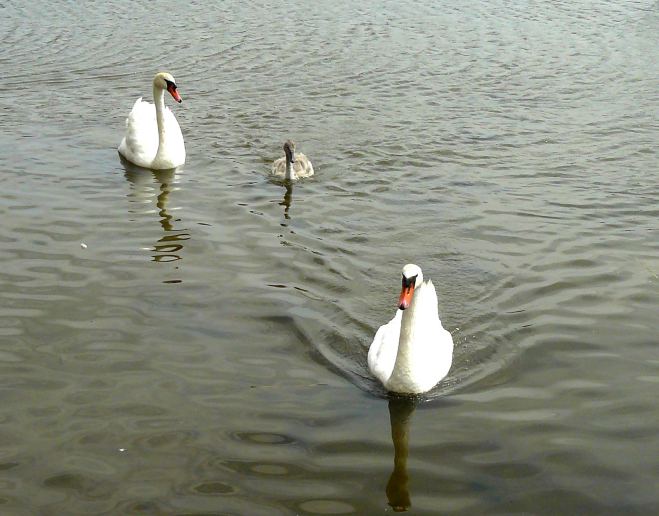
I have suggested to
the Slipper Millpond Association that they temporarily
move the centre raft, where the Great Black-backed
Gulls have nested for the past two years, to the edge
of the pond to discourage any further nesting.
Unfortunately, although these are truly magnificent
birds, their presence has unbalanced the ecology of
this small pond. They are just too big for this small
pond.
Golden Samphire is in
flower on the Hermitage Bridge.
Westbrook
Stream
There were about 20
Pond Skaters on the Westbrook Stream beneath the small
bridge in Victoria Road. I could also see one plant of
Narrow-leaved Water-plantain. There is another one
just over my back garden wall, so they have not all
been lost as I first feared. But there are none in the
usual spot on the Bridge Road Wayside.
HAYLING
OYSTERBEDS
Chris Cockburn
provided the latest news up date from the oysterbeds.
"At least one common
tern chick hatched today and, if it survives and the
other c3 still-sitting common terns produce chicks, it
will be well into September before the breeding season
at the Oysterbeds is finally over! However, there is
no sign of the two chicks that hatched last Friday
(they were last seen on Sunday, but not yesterday or
today). Coincidentally (?!), the juvenile
Mediterranean gull (almost certainly not an Oysterbeds
'product' and that has recently been seen wandering
through the westernmost island at high tide) was seen
swallowing a chick today (before being chased off by
many irate common terns). So, "yes" is the answer to
the question "Do Med juveniles take eggs and small
chicks?"! If continued, this behaviour could result in
an earlier end to the breeding season (ominously,
several Herring gull families have been seen nearby -
also a juvenile great black-backed gull has been
around - to my ears, this bird has a suspiciously
Emsworth-like call!).
Wader roosts are
becoming larger - oystercatchers, ringed plovers, grey
plovers (SP - hooray!), dunlins, turnstones, curlews,
whimbrels, redshanks etc. - but, apart from
great-crested grebes, wildfowl are few & far
between.
Havant BC have done a
thorough job in mechanically-cutting Ragwort spp. and
many other flowering & fruiting plants on the
Mound and the area from the Mound to the Hayling Halt
car park (I am sure that great care was taken to not
disturb or, in any way, damage the Adder population!).
Oddly, since the cut, there are now very few
butterflies and other insects to be seen in these
areas compared to the many that were seen last week -
can anyone suggest why?!!"
I replied to Chris:
"You might be right about the the juvenile Great
Black-backed Gull visiting Hayling Oysterbeds. The
pair that nested on Slipper Millpond here in Emsworth
this year raised three youngsters which have recently
fledged and gone from the pond. But, you will no doubt
be relieved to learn that I have suggested to the
Slipper Millpond Association that they discourage any
further nesting of the Great Black-backed Gulls on the
pond by moving the floating raft where they have
nested for the past two years, to the edge of the
pond. Although these are truly magnificent birds,
their presence has unbalanced the ecology of this
small pond. Early replies from members of the
association indicate general agreement with my
proposal. I suppose they will find somewhere else to
nest and I dread to think but the oysterbeds could be
a suitable spot! "
TUESDAY
AUGUST 6 - 2013
WAYSIDES
NEWS
I checked several of
the Emsworth waysides. Here are the main observations.
A full report along with photos is on the waysides
news blog at . . . http://www.emsworthwaysides.hampshire.org.uk/few-NEWS-current.htm
Slow-worms
I found two
Slow-worms underneath a discarded cardboard box on
the Washington Road path. I had intended to remove the
box, but decided to replace it as a cover for the
Slow-worms. Here is one of these delightful
creatures.
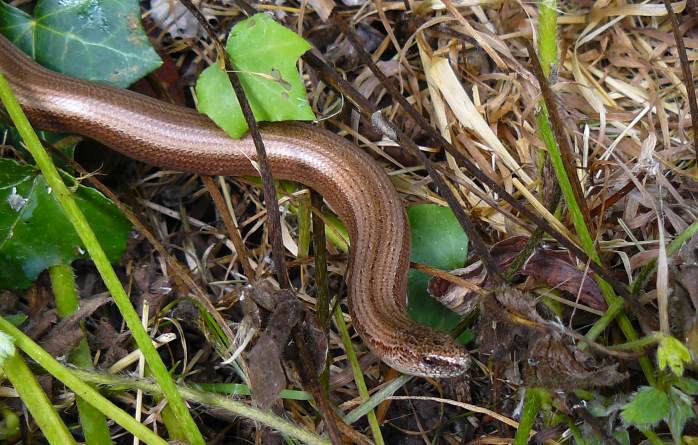
Greater
Burdock
The rare Greater
Burdock is now looking quite magnificent on the
Washington Road path wayside just before you reach the
Emsworth Recreation Ground and is just starting to
flower.

Wild
Clary survives!
About 10 plants of
Wild Clary were still present on the council mown
verge on Christopher Way just to the west of the
official wayside - and they were flowering. They were
not killed by the gas work that took place recently.
There is also one plant still remaining (and in
flower) on the main grass verge wayside about half way
along. So, there is still hope that the colony of 40
plants we have had in previous years will recover,
though not this year.
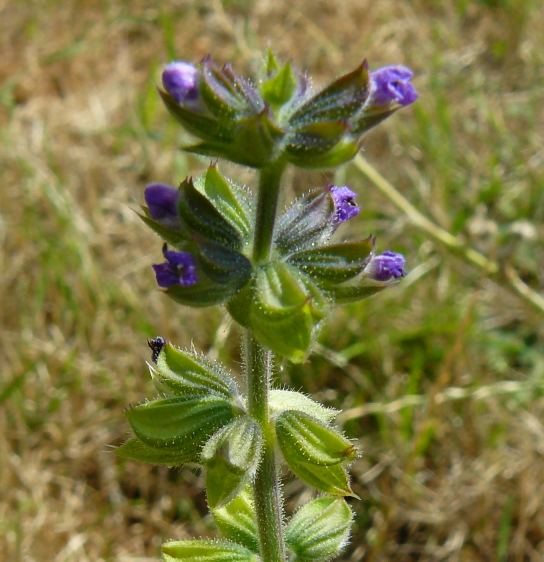
SUNDAY
AUGUST 4 - 2013
BROOK
MEADOW
I went over to the
meadow this morning for the regular conservation work
session which was attended by 12 volunteers. Here they
are ready and waiting at the Lumley gate. There's only
11 in the photo as Wally came in too late for the
photo.
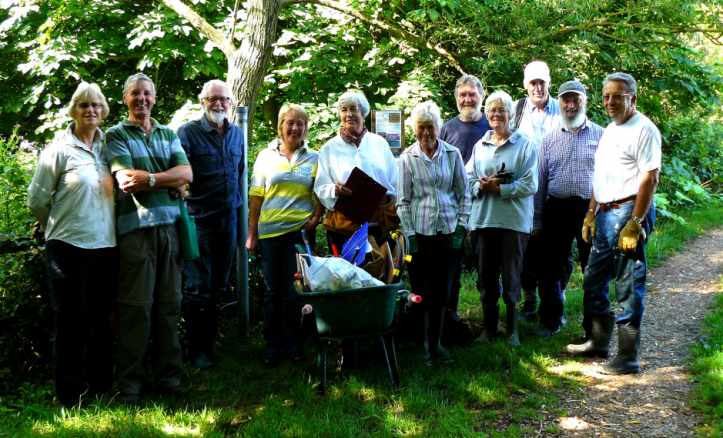
The main tasks were
concerned with clearing away the many fallen willow
branches from the paths through the meadow. This is a
particularly vulnerable time of the year for Crack
Willows the branches of which are heavy with leaves.
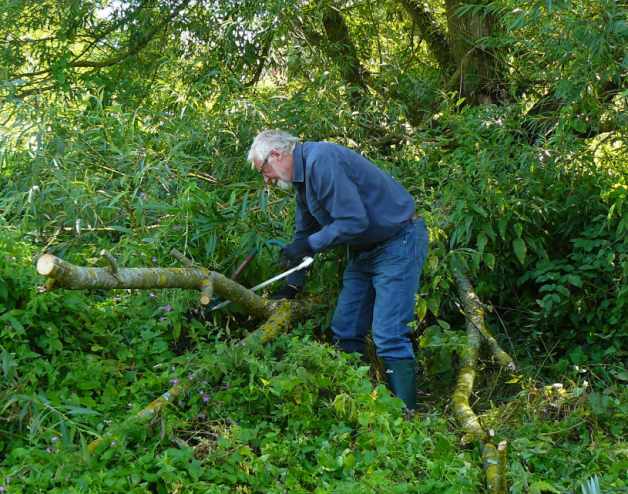
Butterflies
Butterflies were
numerous around the meadow, though few of them stopped
long enough for a photo. The whites were particularly
elusive, though I did identify both Small White and
Large White. Gatekeepers were by far the most common
on the meadow. Here are two I saw feeding together on
Common Fleabane flowers.

I also saw Peacock,
Holly Blue, Small Skipper, Meadow Brown, Comma and Red
Admiral. Speckled Woods were common in the shady areas
in Palmer's Road Copse. But my best butterfly of the
morning was a Painted Lady. I first spotted its
powerful flight in the north west corner of the north
meadow near the thistles. It came to rest on a path in
front of me and I was about to take a photo, when a
dog rushed up and the butterfly was gone! It was my
first of the year, though Ralph Hollins says they are
about though not in large numbers. In fact, this was
my first Painted Lady for two years!
Other
insects
I spent a lot of time
inspecting the flower heads of Hogweed which were
highly attractive to insects, particularly red Soldier
Beetles, flies, hoverflies and Common Wasps. Most
interesting was a Hornet Mimic Hoverfly (Volucella
zonaria) which I found feeding on Hogweed on the
western side of the north meadow.

Hornet
Mimic Hoverfly (Volucella zonaria)
Volucella zonaria is a
large and distinctive hoverfly with a brown thorax and
a yellow abdomen with two thick black stripes. It
looks rather like a Hornet, but is harmless with no
sting. The main observable differences are (1) the
antennae are short in the hoverfly and long in the
hornet and (2) the hoverfly has just two wings and the
hornet has four. Volucella zonaria was recorded on
Brook Meadow by Bryan Pinchen in his insect surveys in
2010 (July and August).
In Great Britain, it
was only known from two specimens prior to 1940, so
was regarded as rare. Since then, it has become
increasingly widespread in many parts of the South and
South East England, often in parks and gardens, where
adults are usually seen visiting flowers. Elsewhere in
England, only a few scattered records exist. The
larvae live as commensals in nests of wasps of the
genus Vespula. Like all Volucella, the adults are
migratory.
Plants
I had a good mooch
around on the west bank of the river in Palmer's Road
Copse. I was pleased to find my first Gipsywort
of the year with its nettle like leaves and tiny
white flowers, dotted purple, in whorls at the base of
the upper leaves. There is a small colony of Gipsywort
plants on both sides of the river north of the south
bridge. This is the best I have known it.
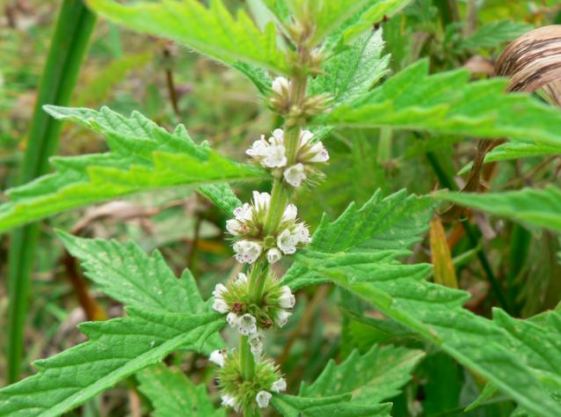
Other plants flowering
on the river bank included Fool's Water-cress,
Brooklime, Blue Water Speedwell (hybrid?), Bittersweet
and Enchanter's Nightshade. The Giant Fescue is
looking great - a tuft is growing beside the first
Willow along the path through the copse from the south
bridge. Blackberries are now ripening on the Brambles
on the north path - the Himalayan variety which are
large and juicy.
Birds
The only observation
of any interest was a churring Greenfinch from the
garden of Gooseberry Cottage - the first I have heard
for some while.
Fungi
Malcolm Phillips sent
me this photo of some fungi that he took on Brook
Meadow today. I am very reluctant to even try to
identify fungi, but they remind me faintly of the
famous Magic Mushrooms (Psilocybe semilanceata) which
were popular in the 1960s as a hallucinogen. Not that
I ever tried them (of course).
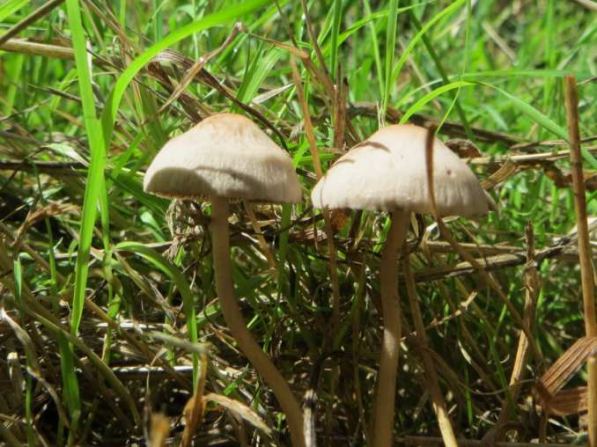
Ralph Hollins thinks
these fungi are unlikely to be Magic Mushrooms
(Psilocybe semilanceata). They would have a small
nipple-like umbo in the centre of the cap which
Malcolm's photo shows no sign of . His best guess
without seeing the fungi is that they might be
Panaeolus semiovatus though that should
have some hint of a ring on the stem and also is said
to grow on Horse Dung which is not present on Brook
Meadow.
SATURDAY
AUGUST 3 - 2013
BROOK
MEADOW
Inane
Hoverfly
Malcolm Phillips
visited Brook Meadow this morning armed with his
mighty camera and got some interesting images of
insects. One that intrigued me was a hover fly with a
distinctive pattern of dark bars on a largely yellow
abdomen which I do not recall having seen on the
meadow before.

I narrowed it down to
Volucella inanis - which the UKSafari
web site refers to as one of the 'Inane Hoverflies'.
The scientific name 'inanis' is Latin for 'inane' or
'empty', possibly referring to the lack of stinging
organ on this wasp-like insect. Its food is nectar and
pollen from a variety of flowers and is found
throughout southern England up to the Midlands from
June to September. These hoverflies resemble wasps for
a very good reason, as the adults lay their eggs in
the nests of bees and wasps, where the larvae feed on
the larvae of those insects. See . . .
http://www.uksafari.com/inane_hoverflies.htm
Southern
Hawker
Among Malcolm's other
photos was a Southern Hawker - a common dragonfly in
summer on Brook Meadow, but the first I have recorded
this year.
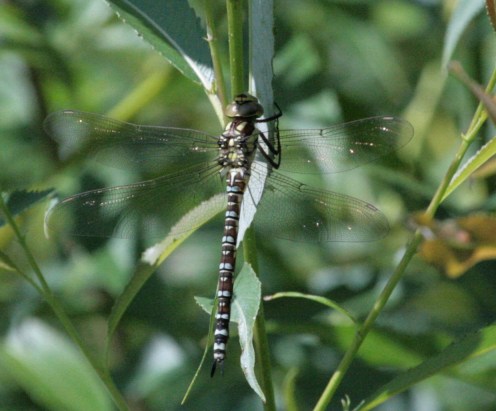
CHARLIE'S
AERIAL NEWS
Charlie Annalls who
lives in Anchorage Way, Portsmouth has had a return
visit from the male Kestrel to her TV aerial. She
says, She was surprised to see the Kestrel so easily
give up his spot as "Arial King of the Aerial" when
harassed by a Magpie. Shortly afterwards the Magpie
flew off after asserting its territorial rights to the
TV aerial.
CORRECTION:
Peter Milinets-Raby pointed out that the Kestrel on
the aerial is in fact a Sparrowhawk - white
dots on mantle, bright yellow legs, rounded wings in
flight and barring on long square edged
tail.
Sparrowhawk
being harassed by Magpie
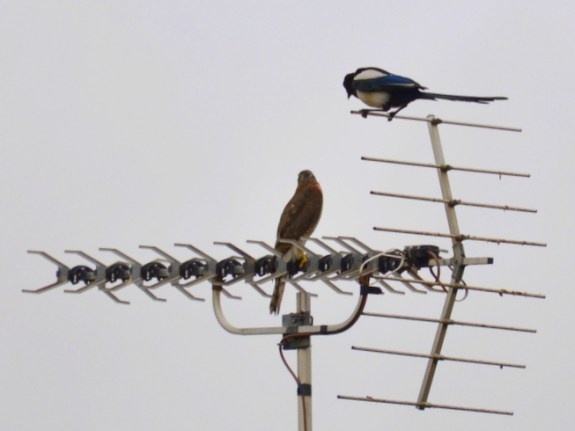
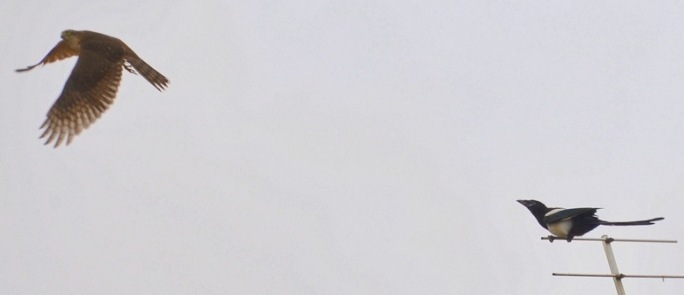
Charlie said the
aerial wasn't empty for long as a rather large family
of Starlings laid claim to it - much to the dismay of
a Collared Dove. Charlie noted how the Starlings are
developing a nice line in iridescent waistcoats at the
moment as the juveniles grow more colourful plumage.
"It's been fascinating watching them develop
throughout the Spring and Summer."

FOLEY
MANOR AND FOLLY POND
Tony Wootton reported
on this morning's walk by Havant Wildlife Group.
"8 of us set off to
have a walk around Foley Manor and Folly Pond, in
lovely sunny fresh conditions. Although it tried to
rain on us several times but with no real success. We
saw meadow browns, gatekeepers, ringlets, large
whites, a large skipper, a peacock, a speckled wood
and a very tired silver washed fritillary, blue
damselflies, soldier beetles, a variety of bees.
Plants: Bell heather, crab apples, greater burdock,
figwort, marsh thistle, creeping thistle, water mint,
yellow loosestrife, and self heal. Birds: Chiffchaff,
3 young whitethroats, swallows, house martins and
swifts. Carrion crow, jackdaws, blackbird, dunnock,
wren, tufted duck with ducklings, mallards, Egyptian
geese, little grebe, great crested grebe, young
nuthatch, green woodpecker, great spotted woodpecker,
spotted flycatcher, then right at the end around 20
siskins and the thin call of a bullfinch."
FRIDAY
AUGUST 2 - 2013
Millpond
News
The Great Black-backed
Gulls have definitely gone from Slipper Millpond, so
all was quiet again. The full story of their nesting
both this year and last year is on a special web page
- with photos. Go to . . . Great
Black-backed Gulls nesting
There was one juvenile
gull, of Herring Gull size (much smaller than the
Great Black-backed Gulls), noisily begging for food at
the Hermitage Bridge along with Coot and Mallard,
including a family of 4 ducklings. Here is the gull
with Coots disputing territory.

The Mute Swan pair
with their one rapidly growing cygnet was on Peter
Pond, where the floating raft had 6 juvenile
Black-headed Gulls. They have had a bumper season on
Hayling Oysterbeds.
THURSDAY
AUGUST 1 - 2013
EMSWORTH
Swifts
A few Swifts were
flying in the sky over Bridge Road today, up to 8 at a
maximum. I suspect these may be birds which are
passing through the area on their way south on
migration back to their wintering grounds in Africa.
Emsworth
Waysides
I had a quick walk
around the new Railway Wayside to the north of the
station ramp. The main embankment below the new ramp
has a mass of wild flowers attracting myriads of bees
and butterflies. I spotted a Common Blue
fluttering around which I have yet to see on Brook
Meadow this year. I could not see any sign of the
special plants we found last August - Marsh Cudweed,
Sharp-leaved Fluellen, Small Toadflax and
Small-flowered Crane's-bill.

Bulrushes are now
flowering in the Westbrook Stream in Bridge Road car
park.
Brook
Meadow
Malcolm Phillips was
on Brook Meadow over the past weekend when he got a
couple good insects. The first is clearly a
Blue-tailed Damselfly with its black abdomen
and bright blue segment 8. The orange colour of the
thorax suggests it is a female.
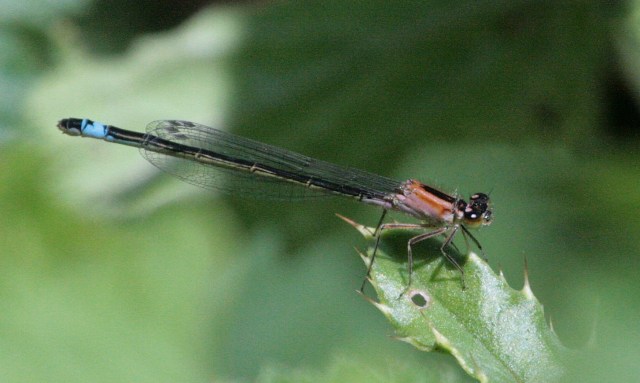
The second is a
Silver Y Moth - one of the few moths I feel
fairly confident about identifying due to the
distinctive Y shaped mark on silvery wings. It is
usually recorded on Brook Meadow during the year.
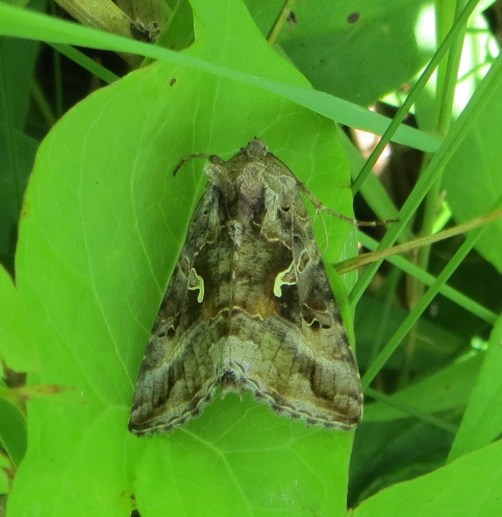
Painted
Lady
During a walk down the
Hayling Billy Line, Brian Lawrence had what is the
first Painted Lady to come to my attention this year.
It is feeding on what looks like Spear Thistle which
is the favourite plant of this butterfly for egg
laying.

Ralph Hollins informed
me that Painted Ladies have been more frequent than I
thought. His database has 52 Painted Lady records for
this year and shows that there was a moderate influx
of them during June. In contrast, Ralph has only 26
records for Clouded Yellow - all between June 18 and
July 9 so presumably they were influenced to move by
the same factors that brought the majority of the
Painted Ladies.
For
earlier observations go to . . July
16-31